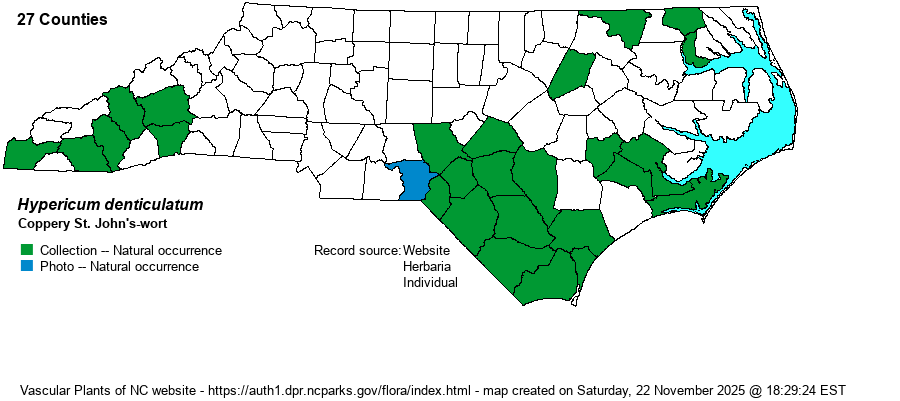| Author | Walter | |
| Distribution | This species – strict sense – is now limited in the state primarily to the southeastern part of the Coastal Plain, mainly north to the Sandhills region and Lenoir County. It is widely scattered elsewhere in the northern Coastal Plain, disjunct to the southern Mountains. Details of its range in the state outside of the southern Coastal Plain are unsettled, owing to a recent split of the larger H. denticulatum; H. virgatum and H. radfordiorum have been removed as separate species. Note that the county dots in RAB (1968) for H. denticulatum var. acutifolium, other than those in Alexander and Wilkes counties, likely now refer to this species.
This revised species is now limited mainly to the Coastal Plain, from southern NJ to eastern GA, and disjunct inland to western NC, central TN, and parts of AL.
| |
| Abundance | In the southern Coastal Plain, it is mostly uncommon to occasionally fairly common, but certainly is not really common except very locally (such as in a few clay-based Carolina bays). Very rare and poorly known in the Mountains and northern Coastal Plain. | |
| Habitat | The strict “H. denticulatum” is found mainly in wetlands, such as clay-based Carolina bays, pine savannas, wet flatwoods, ditches, and other damp but not overly wet ground. | |
| Phenology | Blooms and fruits from June to August. | |
| Identification | See Weakley (2018) for details in separation of this species from H. virgatum and H. radfordiorum. This group of St. John’s-worts are relatively unbranched (except near the top) herbs growing to an average of 1 foot tall. The opposite leaves are typically elliptical and small, growing to about 2/3-inch long; they tend to grow upward (virgate) from the stem and have sessile/clasping bases. In general, the leaves have a light green to blue-green look. At the ends of the branches grow the single flower, which is a golden yellow (not plain yellow) with 5 rotate petals -- the petals are curved usually to the right to resemble airplane propellers. A few other Hypericums also have rotate flowers, such as H. setosum and H. drummondii, but this is the only one with elliptical to rounded leaves that spread virgate from the stem. Though experienced botanists can recognize most herbaceous Hypericum species by leaf characters alone, most beginners will likely need flowers, and perhaps keys, to be sure. | |
| Taxonomic Comments | As mentioned above, this is the ”sensu strictu” taxon of the H. denticulatum from the RAB (1968) manual. In that reference, both H. denticulatum var. denticulatum and most of H. denticulatum var. acutifolium are now a part of the new species.
| |
| Other Common Name(s) | None | |
| State Rank | S3? | |
| Global Rank | G5 | |
| State Status | | |
| US Status | | |
| USACE-agcp | FACW link |
| USACE-emp | FACW link |

